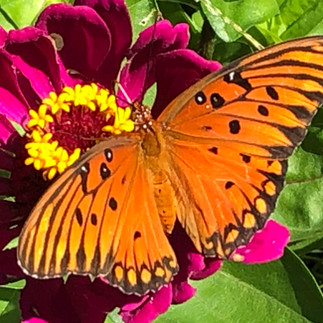Gulf Fritillary Butterfly
- Autumn Shultz

- Jul 5, 2021
- 1 min read
Also known as: Passion Butterfly
Scientific name: Agraulis vanillae (Linnaeus)
Photos by: Autumn Shultz
Females lay the small yellow eggs singly on or near leaves, stems or tendrils of passionflower vines. Females are typically distinctively larger in size than males. The underside of the wings is brown and speckled with silvery white dots. In contrast, the top surface layer of the wings is deep orange in color with black streaks running across. In addition to the size difference between the two sexes, females are usually darker in color and are more marked with black streaks as compared to the males.
Host plants are passionflower vines, but adults also eat nectar from many flowers, including Lantana, Butterfly Bush, Zinnia, Aster, Thistle, Verbena, and others.
As a defense, gulf fritillaries can emit an odor to ward off bird predators.
Egg, chrysalis, and caterpillar Photos from WikiCommons by: Edward Rooks
Beneficial?
Sure! Gulf Fritillaries are pollinators of several flowers.
----------
So are Gulf Fritillaries ok to leave in the garden?
Absolutely. We love chasing (and photographing) butterflies in the community garden.
Photos of life stages: https://entnemdept.ufl.edu/creatures/bfly/gulf_fritillary.htm















Comments